Yoga Poses, the ancient practice of physical postures, mind control, and breathing exercises, has exploded in popularity in recent years.
Its appeal is multifaceted, offering a path to improved flexibility, strength, stress reduction, and overall well-being. But for beginners, the sheer number of Yoga Poses (asanas) can feel overwhelming.
Worry not! This guide will introduce you to some fundamental Yoga Poses, categorized by their focus, to help you embark on your yogic journey with ease.
Table of Contents
ToggleStanding Yoga Poses:
Standing Yoga poses, often the foundation of a yoga practice, build strength, stability, and balance. They also improve circulation and posture.
1. Mountain Pose (Tadasana):
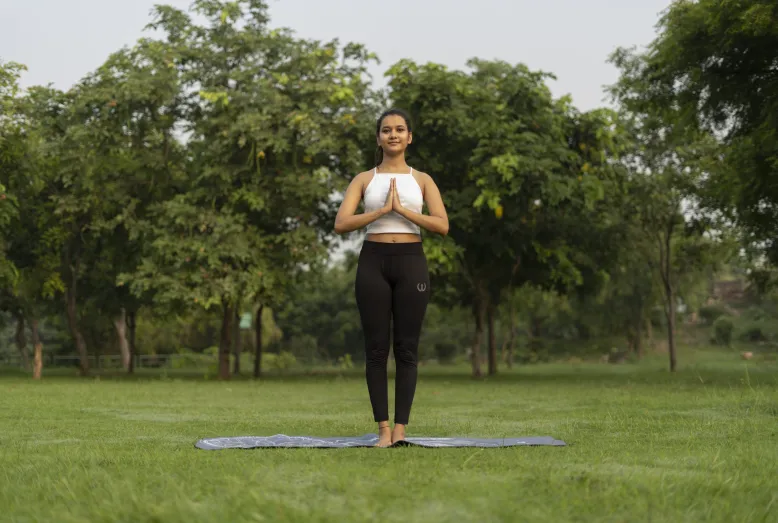
Mountain Pose improves posture and alignment by strengthening core muscles and promoting spinal alignment.
It enhances body awareness by requiring focus on various body parts. Engaging the core and legs boosts balance and stability.
The pose also strengthens the legs and core by gently engaging various muscle groups, including the legs, core, and back.
Learn More: How to Do Tadasana Benefits Of Tadasana
2. Downward Facing Dog (Adho Mukha Svanasana):
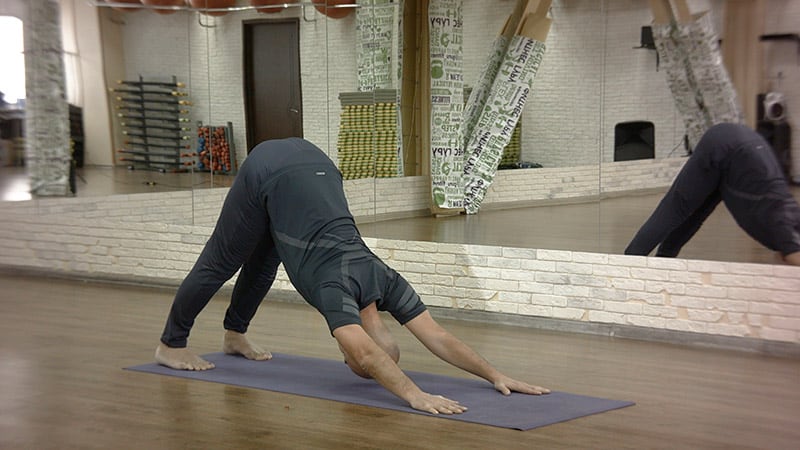
The Downward-Facing Dog pose is a beneficial exercise that strengthens and stretches various muscle groups,
improves circulation by positioning the heart above the head, calms the mind by focusing on breath,and boosts energy by leaving the body feeling refreshed.
It also promotes relaxation and reduces stress.
Learn More: How to Do Adho Mukha Svanasana
3. Warrior I (Virabhadrasana I):

The pose strengthens legs by engaging the quadriceps, hamstrings, and calves, improving balance by challenging one’s balance.
It also strengthens hips and hamstrings by stretching hip flexors, hamstrings, and groin muscles.
The powerful stance and grounded feeling boost confidence, leaving the practitioner feeling empowered.
4. Warrior II (Virabhadrasana II):

The pose strengthens legs and core, improves balance by extending one leg, increases flexibility by stretching hips, hamstrings, and shoulders, and boosts confidence
Providing a grounded feeling similar to Warrior I. It also challenges balance and strengthens the core, enhancing overall physical and mental health.
5. Malasana (Garland Pose):

Malasana, a Yoga Pose, promotes flexibility, boosts digestion, enhances balance, and promotes concentration.
It stretches the ankles, groins, and back, enhancing the range of motion for everyday activities. According to yoga tradition, it stimulates the digestive system by encouraging a downward flow of energy, aiding in smoother elimination and potentially alleviating constipation.
The grounding nature of Malasana, combined with gentle pressure on the inner thighs, brings awareness inward, promoting calmness and focus.
Learn More: How to Do Malasana
6. Parsvottanasana (Intense Side Stretch Pose):
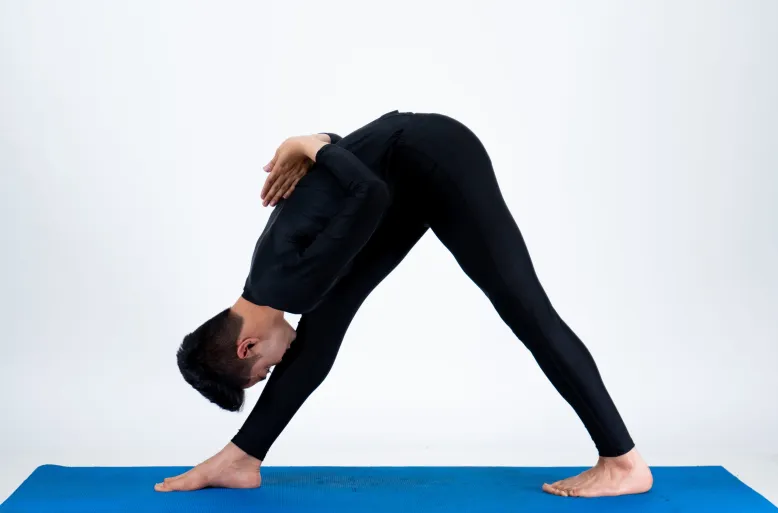
The forward bend pose is beneficial for various reasons, including strengthening the hamstrings and calves, opening the hips and spine, strengthening the legs and core muscles, improving balance, and reducing stress and anxiety.
It involves deep breathing and meditative poses, which promote a better range of motion and posture, and engage the legs and core muscles for proper alignment and stability.
Balancing on one leg while reaching forward also enhances balance.
Learn More: How To Do Parsvottanasana
7. Urdhva Hastasana (Upward Salute Pose):
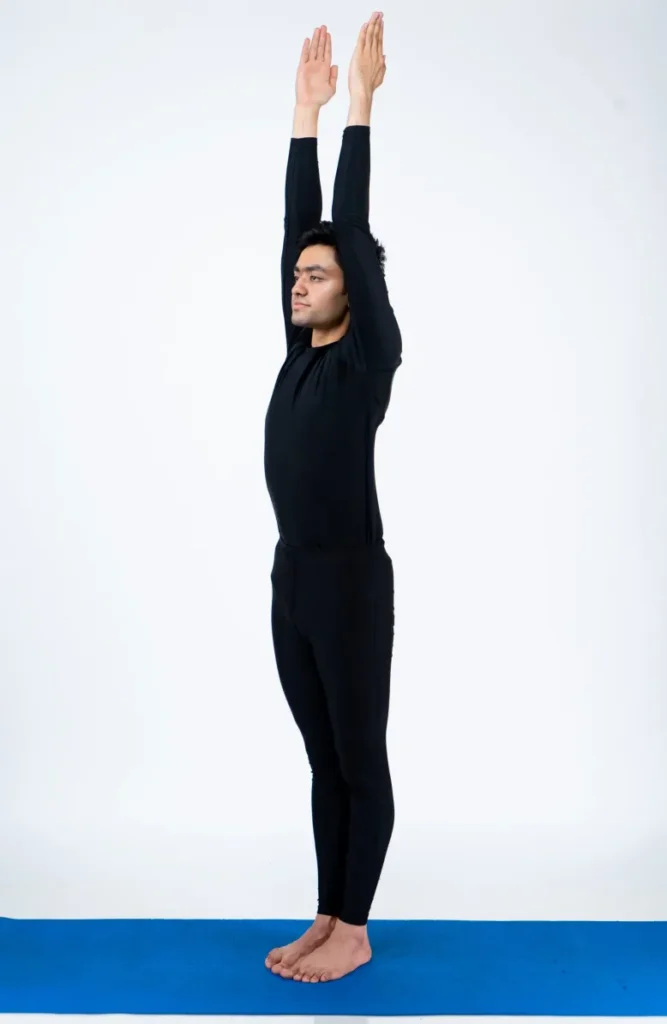
The pose improves posture by stretching the spine and engaging core muscles.
It gently stretches the entire body, including arms, chest, shoulders, spine, legs, and neck.
The upward reach and deep breathing boost energy, leaving the body feeling refreshed. Standing on one leg challenges balance and requires core engagement for stability.
Learn More: How to do Urdhva Hastasana
8. Trikonasana (Triangle Pose):
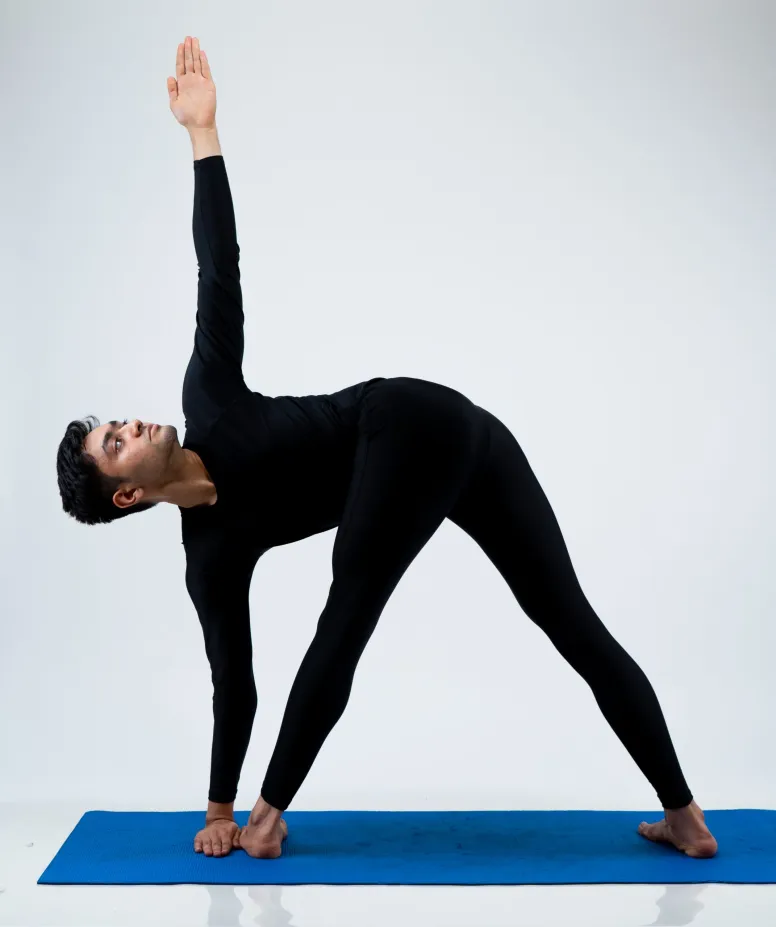
Trikonasana is a pose that strengthens legs and core, improves flexibility, enhances balance, boosts circulation, and promotes mental focus.
It involves engaging leg muscles like the quadriceps, hamstrings, and calves, while also promoting a greater range of motion.
The pose also challenges balance by requiring core strength for stability. The side stretch also improves blood flow throughout the body. It also promotes mental focus by focusing on breathing.
Learn More: How To Do Trikonasana , Benefits of Trikonasana
9. Ardha Uttanasana (Half Forward Bend):
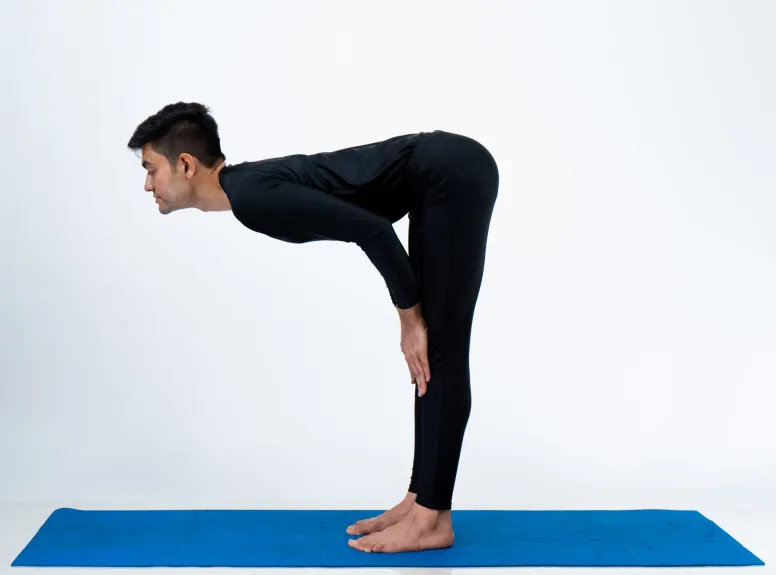
The forward bend exercise improves lower body flexibility by stretching the hamstrings and calves, strengthening the back and core, and enhancing posture.
It also lengthens the spine, reducing tension and promoting circulation.
The gentle compression stimulates internal organs, while deep breathing and downward movement promote relaxation, reducing stress and calming the mind.
Sitting Yoga Pose:
Sitting Yoga Poses, also known as seated postures (asanas) in Sanskrit, are fundamental positions that form the bedrock of many yoga practices.
These Yoga Poses offer a plethora of benefits, ranging from improved flexibility and posture to stress reduction and meditation.
Here’s a glimpse into some popular sitting Yoga Poses, categorized by their focus:
1. Sukhasana (Easy Pose):

Sukhasana is a Yoga Pose that offers numerous physical and mental benefits. It improves posture by strengthening core muscles and promoting proper spinal alignment.
It also increases flexibility by gently stretching the hips, ankles, and knees, reducing tightness.
Sukhasana promotes relaxation by creating a calm, supported position, reducing muscle tension, and promoting refreshedness.
It also enhances focus and concentration, particularly during meditation, by focusing on breath. It also promotes mindfulness, fostering awareness of the body and breath, aiding in stress management and overall well-being.
Sukhasana is beginner-friendly, requiring minimal flexibility, and can be used for various purposes, including resting during yoga, reading, or focusing on breath.
Learn More: How to Do Sukhasana
2. Paschimottanasana (Seated Forward Bend):
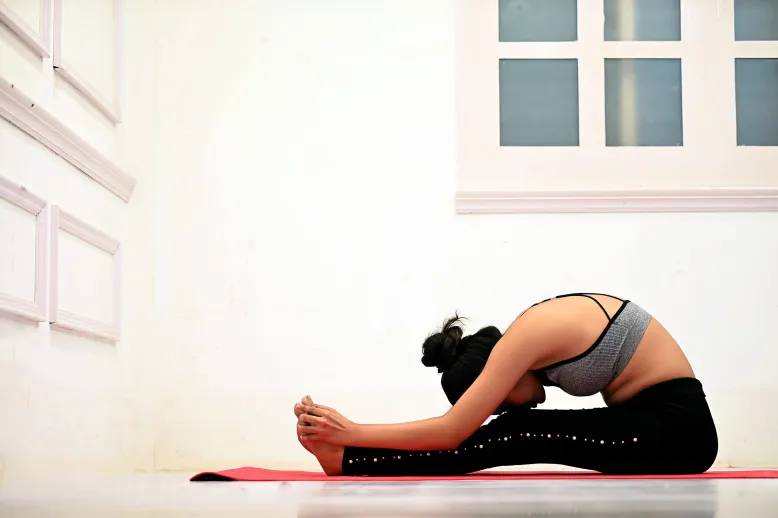
Paschimottanasana is a pose that improves hamstring flexibility, lengthens the spine, stimulates digestion, calms the mind, and increases blood flow to the hamstrings and lower back when practiced regularly.
Its deep stretch to the hamstrings, which are muscles along the back of the thighs, promotes better posture and reduces tension in the back. Regular practice can also improve blood flow to these areas.
Learn More: How to Do Paschimottanasana, Benefits Of Paschimottanasana
3. Baddha Konasana (Bound Angle Pose, Cobbler's Pose):
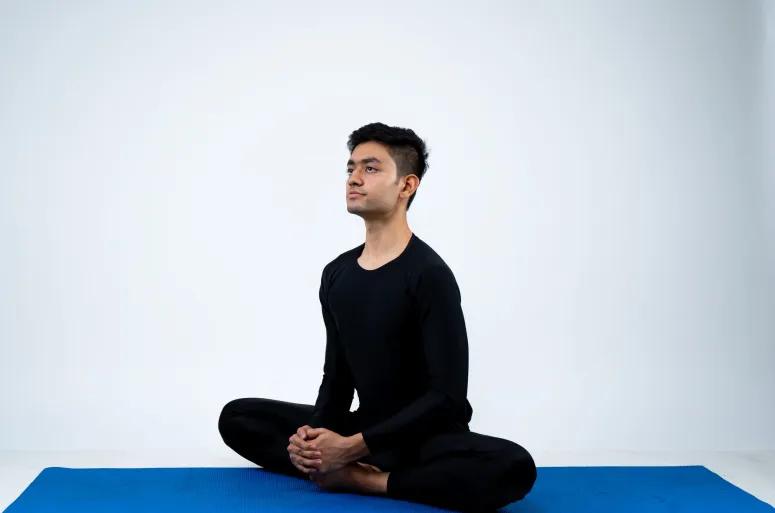
Baddha Konasana is a pose that improves hip and inner thigh flexibility by stretching the adductor muscles, increasing their range of motion, and reducing tightness.
It promotes relaxation by gently opening the hips and stretching the inner thighs, releasing tension and promoting lower body relaxation.
The gentle pressure in the inner thighs stimulates circulation, aiding in recovery. Additionally, Baddha Konasana may indirectly improve posture by lengthening the spine and opening the hips.
Learn More: How to do Baddha Konasana
4. Ardha Matsyendrasana (Half Lord of the Fishes Pose):
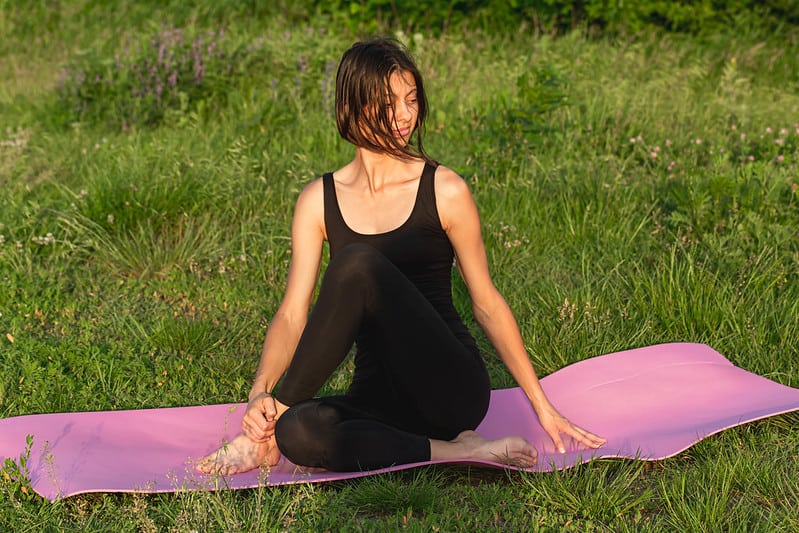
The pose involves a twist that enhances spine and hip flexibility, detoxifies the body, stimulates the digestive system, and promotes mental well-being.
The twisting action opens the spine, hips, and shoulders, reducing stiffness and increasing the range of motion. However, there is limited scientific evidence supporting this claim.
The pose also promotes better abdominal circulation and calms the mind, reducing stress.
Learn More: How to Do Ardha Matsyendrasana Benefits of Ardha Matsyendrasana
5. Dandasana (Staff Pose):
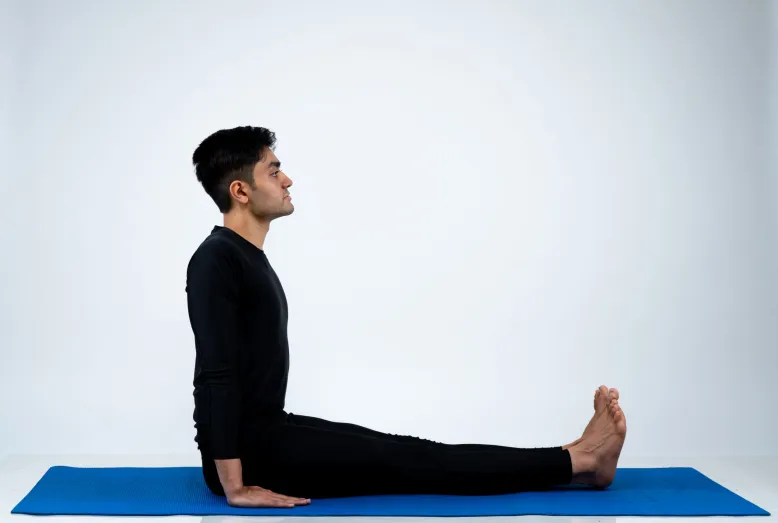
Dandasana is a Yoga Pose that improves posture by strengthening core muscles and promoting spinal alignment.
It also stretches the hamstrings and calves, improving flexibility. The pose increases body awareness by requiring awareness of breath and alignment.
Dandasana serves as a foundation for other seated poses, building strength and stability.
Learn More: How to Do Dandasana
6. Upavistha Konasana (Seated Wide Angle Forward Bend):
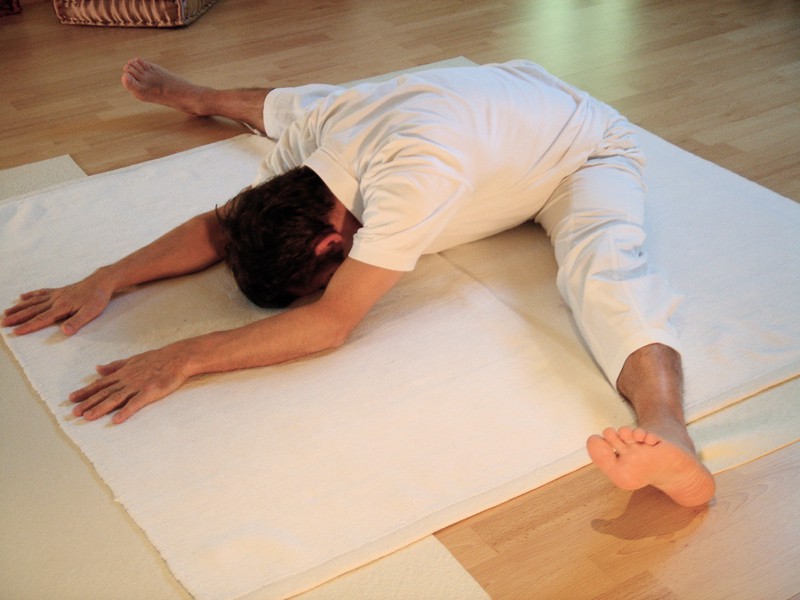
Upavistha Konasana is a pose that enhances hamstring and inner thigh flexibility by stretching the muscles, increasing the range of motion, and reducing tightness.
It prepares the body for other poses, improves circulation to the legs and pelvic area, and promotes relaxation by focusing on breathing and reducing stress.
Learn More: How to Do Upavistha Konasana
7. Janu Sirsasana (Head-to-Knee Forward Bend):
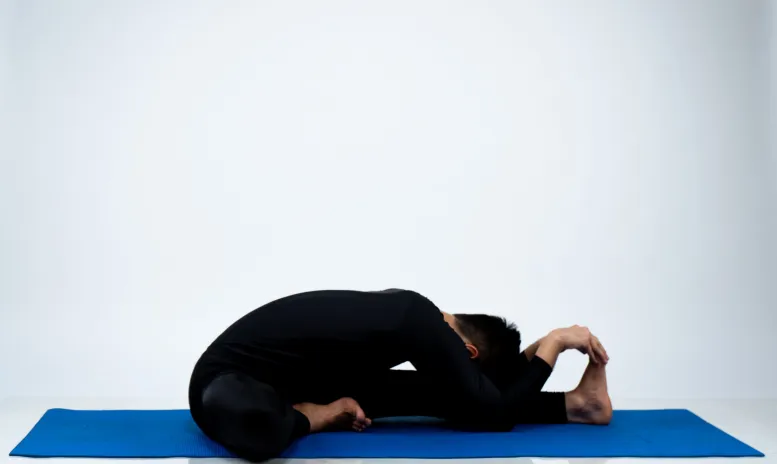
Janu Sirsasana is a pose that improves hamstring flexibility, strengthens core and back muscles, and lengthens the spine.
It involves a deep stretch to the hamstrings, which are muscles along the back of the thighs. The forward bend also stretches and lengthens the spine, improving flexibility and posture.
The pose also stimulates digestion through gentle compression in the abdominal area.
Learn More: How to Do Janu Sirsasana
8. Padmasana (Lotus Pose):
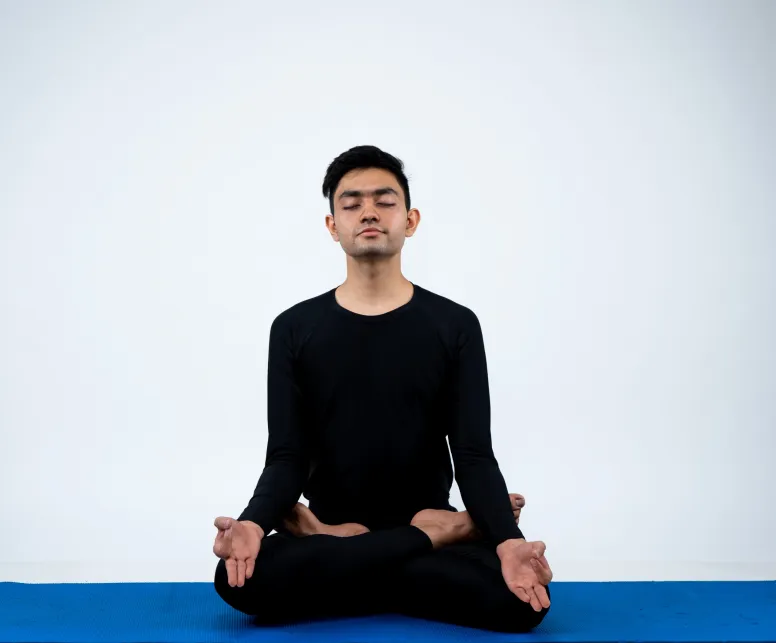
Padmasana, a pose with potential benefits such as improved hip and ankle flexibility, can also promote meditation.
However, it can lead to injuries if not properly prepared. The pose’s stability can also hinder focus and concentration. It’s important to note that Padmasana may not be suitable for everyone due to its demanding nature and potential harm.
Other comfortable seated poses can also support meditation without the risks associated with Padmasana.
Learn More: How to Do Padmasana, Benefits Of Padmasana
Resting Yoga Poses:
Resting Yoga Poses, also known as restorative poses, are designed to promote relaxation, ease tension, and allow your body to fully unwind.
These gentle postures are typically held for longer durations (3-5 minutes or even longer) with the support of props like bolsters, blankets, and blocks to ensure complete comfort and minimize muscle engagement.
Here are some popular resting Yoga Poses:
1. Savasana (Corpse Pose):
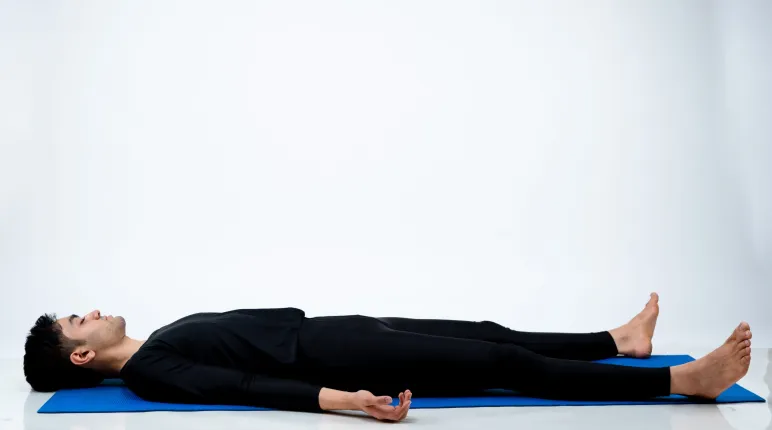
Promotes relaxation and stress reduction by allowing the body and mind to completely unwind.
Reduces blood pressure and heart rate, inducing a state of deep rest. Helps to integrate the benefits of the yoga practice, allowing for physical and mental rejuvenation.
Cultivates mindfulness and awareness of the present moment. Can aid in relieving mild anxiety, depression, and insomnia.
Learn More: How to Do Savasana, Benefits Of Savasana
2. Balasana (Child's Pose):

Stretches the hips, thighs, and ankles, relieving tension in these areas.
Calms the mind and helps reduce stress and anxiety. Encourages deep breathing, which can promote relaxation and improve lung function.
Relieves tension in the back, neck, and shoulders. Provides a gentle stretch for the spine, aiding in flexibility and mobility.
Learn More: How to Do Balasana, Benefits of Balasana
3. Supta Baddha Konasana (Reclining Bound Angle Pose):
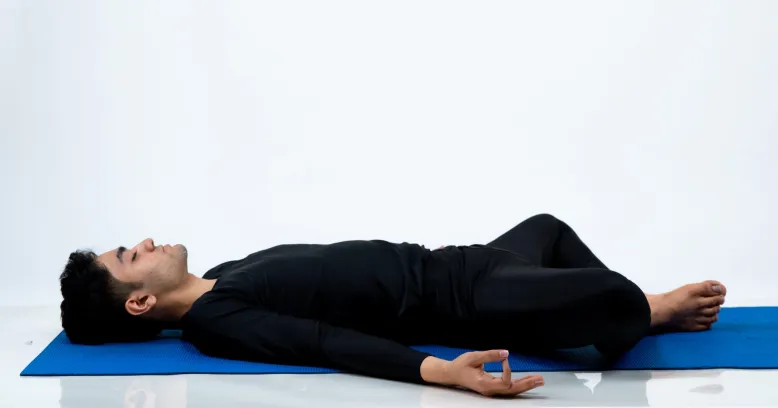
Opens the hips, groin, and inner thighs, increasing flexibility in these areas. Relieves tension in the lower back and pelvis.
Stimulates the abdominal organs, aiding digestion and elimination.
Calms the nervous system and promotes relaxation, making it beneficial for stress relief. Can help alleviate symptoms of menstrual discomfort and menopause.
Learn More: How to Do Supta Baddha Konasana
Balancing Yoga Pose
Balancing Yoga Poses challenges to your physical and mental stability, offering a multitude of benefits that extend far beyond simply staying upright.
Here’s how incorporating these poses into your practice can enhance your well-being:
1. Uttanasana (Standing Forward Bend):
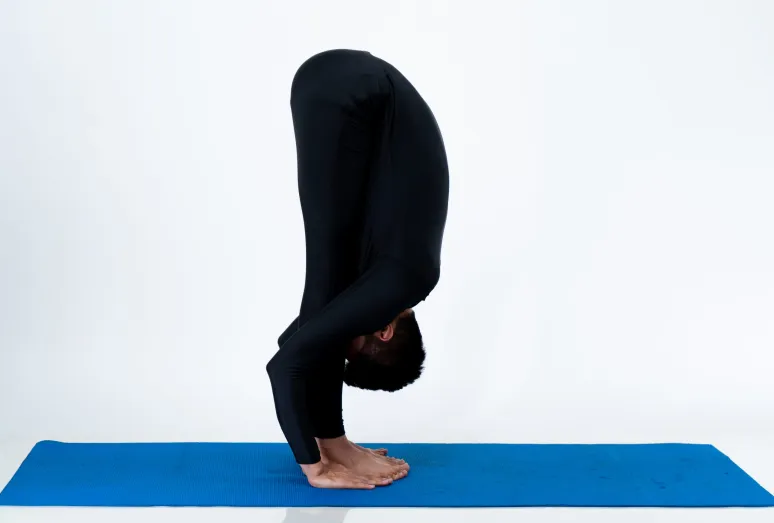
Stretches the entire back body, including the hamstrings, calves, and spine. Relieves tension in the neck, shoulders, and upper back. Calms the mind and soothes stress and anxiety.
Stimulates the abdominal organs, aiding digestion and elimination. Increases blood flow to the brain, improving concentration and mental clarity.
Learn More: How to Do Uttanasana
2. Phalakasana (Plank Pose):
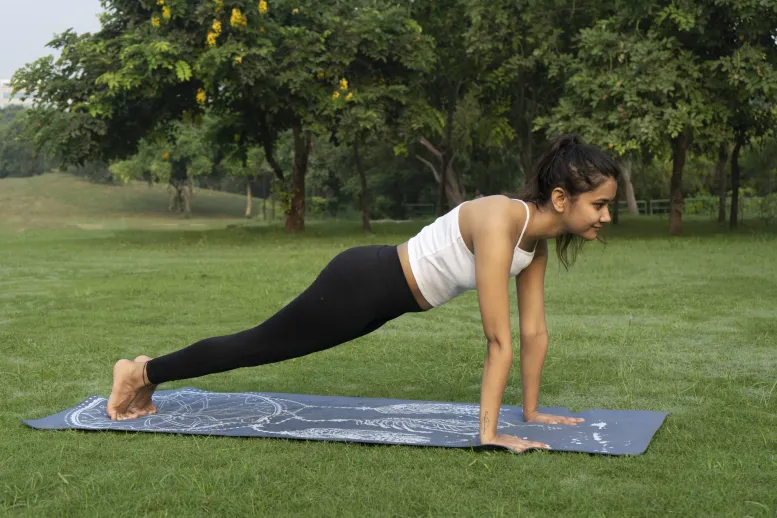
Strengthens the core muscles, including the abdominals, obliques, and lower back. Tones the arms, shoulders, and chest. Improves posture and stability, helping to prevent back pain and injury.
Increases wrist strength and flexibility. Builds endurance and stamina, especially in the upper body.
3. Anjaneyasana (Low Lunge Pose):
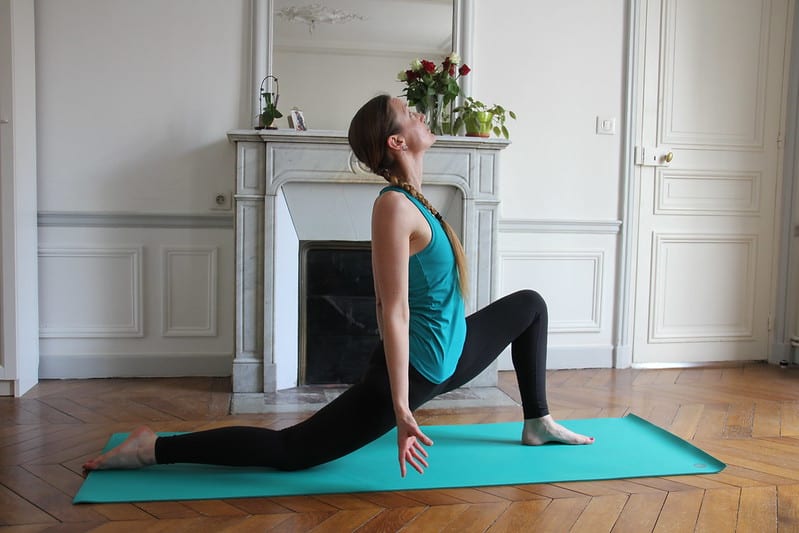
Stretches the hip flexors, quadriceps, and groin muscles. Opens the chest and shoulders, improving posture and lung capacity.
Strengthens the legs, especially the quadriceps and glutes. Improves balance and coordination. Can help alleviate tension in the hips and lower back.
Conclusion
While these 23 poses offer a foundation for beginner yogis, remember that yoga is a journey, not a destination.
Be patient with yourself, listen to your body, and don’t hesitate to modify poses as needed.
Explore different variations, find a practice that suits your needs and preferences, and most importantly, enjoy the journey towards a healthier and happier you!
Frequently Asked Questions ?
Asanas are also known as Yoga Poses or postures in English.
Traditionally:
84 poses: This is the symbolic number mentioned in some ancient yoga texts like the Goraksha Sataka and the Hatha Yoga Pradipika. However, these texts describe only a fraction of these poses, and the specific poses included vary between different interpretations.
Contemporarily:
Around 200 poses in yoga, This is a more practical estimate for the number of distinct and commonly practiced poses found in modern yoga. This includes variations and modifications of the same basic pose.
Yoga offers numerous physical benefits, including improved flexibility, strength, balance, coordination, pain relief, cardiovascular health, posture improvement, stress management, better sleep, mood enhancement, self-awareness, and improved focus and concentration.
Its stretching, deep breathing, and meditation techniques promote muscle strength, balance, and coordination, while also reducing the risk of musculoskeletal problems.
Yoga also promotes better sleep quality, better mood, and increased self-awareness, making it a beneficial exercise for overall health.
There is no single “best” pose for beginners, as different poses offer different benefits and target different body areas.
Some good starting points include the Mountain Pose (Tadasana), Downward-Facing Dog (Adho Mukha Svanasana), Child’s Pose (Balasana), Sukhasana (Easy Pose):, and Warrior I Pose (Virabhadrasana I). Mountain Pose helps establish proper body alignment, strengthens core and leg muscles, and improves balance.
Downward-Facing Dog stretches the entire body, strengthens arms, core, and legs, and improves circulation. Child’s Pose provides a gentle stretch to the back, hips, and thighs, and is a great option for breaks during practice.
A sustainable approach is to start with 2-3 sessions per week, gradually increase the duration as strength and flexibility increase.
Prioritize proper form over duration and take rest days when you feel sore or fatigued. The best practice frequency depends on your individual needs and fitness level.
Consulting a certified yoga instructor can help create a personalized plan that aligns with your goals and limitations.
Source: Wiki


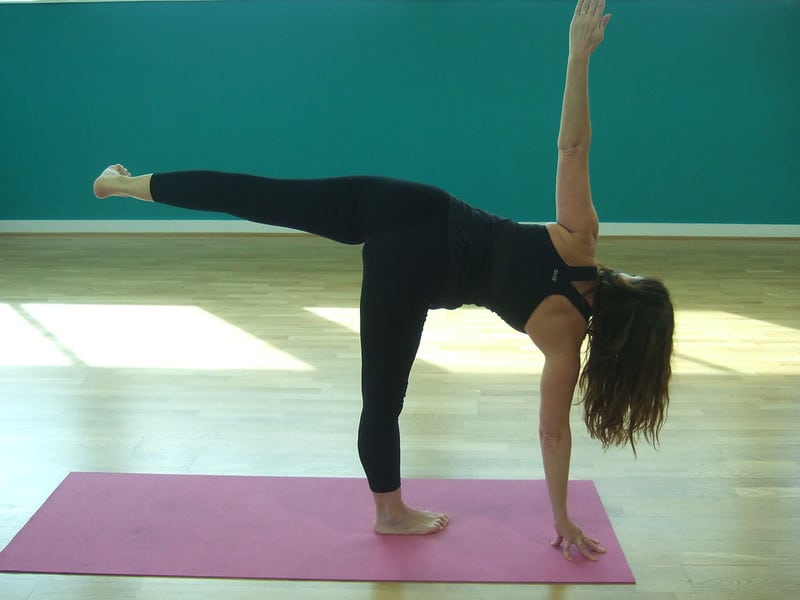

No Comments